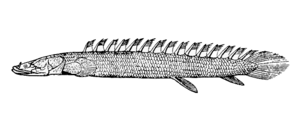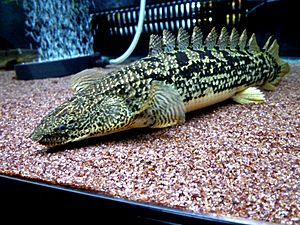Bichir facts for kids
Bichirs and the reedfish are a special family of fish called Polypteridae. They look quite ancient and are the only family in their group, Polypteriformes.
These fish live in fresh water in warm parts of Africa, including the Nile River. They especially like swampy, shallow areas and places where rivers meet the sea. Bichirs are considered very old types of ray-finned fish, related to some of the earliest fish on Earth.
Quick facts for kids Bichir |
|
|---|---|
 |
|
| Nile bichir Polypterus bichir | |
 |
|
| Barred bichir Polypterus delhezi | |
| Scientific classification |
|
| Kingdom: | Animalia |
| Phylum: | Chordata |
| Class: | Actinopterygii |
| Subclass: | Cladistia |
| Order: | Polypteriformes Bleeker, 1859 |
| Family: | Polypteridae Bonaparte, 1835 |
| Type species | |
| Polypterus bichir Lacepède 1803
|
|
| Genera | |
|
Erpetoichthys |
|
Contents
What Bichirs Look Like
Bichirs are long, snake-like fish. Instead of one long fin on their back, they have many small fins called dorsal finlets. There can be anywhere from seven to 18 of these finlets. Each finlet has a double-edged tip and is the only part of their fins with spines. The rest of their fins are soft.
Their bodies are covered in thick, diamond-shaped scales that look like bone. These are called ganoid scales. Bichirs also have fleshy pectoral fins (fins near their head) that look a bit like the fins of lobe-finned fish. On top of their heads, they have two small holes called spiracles, which they use to breathe air. They also have two lungs, like humans, but their left lung is shorter than their right.
Bichirs can grow to different sizes. Some are about 25 cm (9.8 in) long, while others can be over 100 cm (39 in) (about 3 feet) long!
What Bichirs Eat
Bichirs are active at night. They hunt for small animals like other fish, crabs, and insects. If you have a bichir in an aquarium, they often eat bloodworms, which are a type of insect larva.
How Bichirs Breathe Air
Bichirs have a special ability: they can breathe air! They have a pair of lungs connected to their throat. They use these lungs to breathe air from the surface when the water they live in doesn't have enough oxygen. Their lungs have many blood vessels to help them take in oxygen.
Unlike most other animals with lungs, bichir lungs are smooth sacs, not spongy like human lungs. Bichirs often prefer to breathe air using the small holes on their heads (spiracles) when they are not disturbed or when the water is very shallow.
Bichirs as Pets
Bichirs are popular fish for large home aquariums and public aquariums. Sometimes, pet shops call them "dragon bichirs" or "dragon fins" because they look a bit like dragons. Even though they hunt smaller animals, they are usually peaceful and like to rest at the bottom of the tank. They can live well with other fish that are too big to be eaten. Some people who keep bichirs notice that catfish might bother them, but usually don't harm them. Bichirs can live up to 10 years in an aquarium.
Types of Bichirs
There are two main groups of living bichirs: Polypterus and Erpetoichthys. There are also some types of bichirs that are now extinct (no longer alive), like Bawitius.
Here are some of the known species:
- Erpetoichthys calabaricus (also known as the reedfish)
- Polypterus (this group includes many species like):
- Polypterus bichir (Nile bichir)
- Polypterus congicus (Congo bichir)
- Polypterus delhezi (Barred bichir)
- Polypterus endlicheri (Saddled bichir)
- Polypterus ornatipinnis (Ornate bichir)
- Polypterus senegalus (Gray bichir)
Images for kids
See also
 In Spanish: Poliptéridos para niños
In Spanish: Poliptéridos para niños



